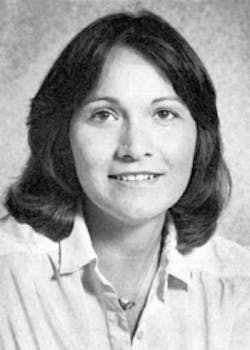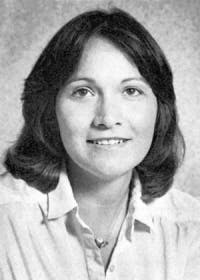Irene Woodall quotes
Irene Woodall, as picture in RDH magazine in 1981.
Irene Woodall was RDH magazine’s Senior Consulting Editor from 1981 until Jan. 1, 1993, when she was hospitalized with an aneurysm, and she has suffered from many long-term effects of that illness. After her Feb. 1993 column, her original work for the magazine ceased, although the magazine did reprint older columns for awhile afterwards. Her commentaries always appeared in the front of the magazine, and were very popular with the dental hygienists of the 1980s. Some selected quotes from her articles appear below.
- The role of the dental hygienist can be a lonely one unless there is an opportunity for collegial exchange and a feeling of unity and purpose. (January 1981)
- Dental hygiene’s lack of preparedness for the economic costs we currently endure, partly as a direct result of our growth in size, does not speak well of our foresight and initiative ... We have grown in size, but have not been able to pull together to shape our future. (March 1981)
- As the economic crunch is felt by employer-dentists, the screws are tightened on their employees, including hygienists, especially if the dentists think hygienists are overpaid. (May 1982)
- An entire group of us were educated in that [legal] process, which resulted in the modification of numerous state practice acts during the late 1960s and 1970s. We began to think about the implications of the laws and to openly consider alternatives. Many of us also found that following the proper channels can be a slow, disappointing, and incredibly political process. Very few of us have chosen civil disobedience in order to bring about change, although after a day of circular arguments in a state board hearing, nonviolent disruption can be appealing. (September 1984)
- Many hygienists with years of experience find they have little room for financial growth in a dental practice (as an employee), and sometimes their experience and accrued raises (such as they are) are a liability. A dentist may decide to replace a hygienist with a younger one who will work for less. (March 1985)
- Service became an obligation rather than a contractual agreement. Such a view fits with the pedestal women have been placed upon. We are above tangible reward; we are virtuous and holy. The view also fits with the thinking of smart employers (usually men) who see the long-term financial benefit of instilling in employees the “more important rewards” of a service orientation. (July 1985)
- There is one roadblock to major change for dental hygiene. We have the resources, the people, the intelligence, the commitment, the energy, and even the possible paths to follow. But we are lacking a crucial element if we are to succeed with our respective dreams. This missing link is a clear image of how dental hygiene is unique as a profession. (October 1987)
- How can we specify our research goals or our proper place in the continuum of patient care, or upgrade our educational programs, or tell the public about ourselves, if we see ourselves as appendages to dentistry? (January 1988)
- We become a resource for each patient. If we project an aura of competence, interest, and concern, we may be seen by many patients as having an independent opinion regarding care. They may believe that if they ask us, we would be willing to honestly express that opinion. (April 1988)
- I could be wrong, but I think there is more possibility of equity for dental hygiene in the research arena than in most other opportunities open to us. We are not prevented from doing research because of state practice acts. We are not prevented from taking the microphone and addressing an audience. We are free to collaborate with dental and dental hygiene colleagues on a wide array of topics regardless of a local dental association’s politics. Our papers are not turned down because one or all of the researchers are dental hygienists. We are reviewed fairly and openly by our researcher peers and regardless of their fame. (May 1989)
- Envisioning today’s dentists teaching fledgling would-be hygienists to perform instrumentation is a nightmare for me. That doesn’t mean they aren’t well-intentioned dentists. I just don’t have much confidence that they know as much about curette shape, adaption, and root anatomy as well as educated dental hygienists. (October 1989)
- Hygienists should not be considered “tooth cleaners” or “caries finders” who move patients in and out of pre-defined dental hygiene appointments designed to prepare the patients for restorative care. Hygienists are now most valuable in taking the time to perform complete periodontal chartings and examinations, including newly developed bacteriological and enzyme-detecting diagnostic tests. Hygienists should know the subtleties of soft tissue change and then be able to use the most highly refined technical skills to prepare the teeth and periodontium to health and be maintained in a state of health. (July 1990)
- We have not really solved issues over the past 25 years; rather, we keep fighting them with minimal improvement in our lot. One of the examples I gave was preceptorship. We fought and won that issue in the 1970s, but we didn’t solve it. It is back today, with the same point and counterpoint arguments. I complained that it was all very tiring and that we really need to look at a new future for ourselves and to focus on one issue at a time with perhaps greater likelihood that it will be solved. (September 1990)
- The AAP and the ADA are now jointly promoting a program to encourage general dentists to look for and find periodontal disease. It is ironic and illogical that a whole profession, dental hygiene, already has these skills while being ignored as a contributor to solving the problem of under-identification and under-diagnosis. (May 1991)
- All the great ideas and need for involvement in the dental team die quickly if you are pigeon holed as the “girl who cleans teeth.” For those of us who have strong needs to belong and be appreciated for what we contribute, going to work every day becomes a chore when those needs are unmet. (June 1992)
- To prepare ourselves, our patients, and our entire dental team for the rapid evolution, we need to stop defining what we do as “cleanings.” Call it “dental hygiene care,” “assessment and prevention,” “preventive periodontal care,” “supportive periodontal care,” “continuing care,” or “comprehensive dental hygiene care,” but let’s stop using the “c” word. (August 1992)
- I would love to see us channel our vitality and commitment into a unified, grassroots involvement that focuses on the evolution of our profession. I would love to see a renewed focus on productivity and quality, but with these terms having a much different meaning from their traditional connotation. (February 1993; article was submitted prior to January hospitalization)

